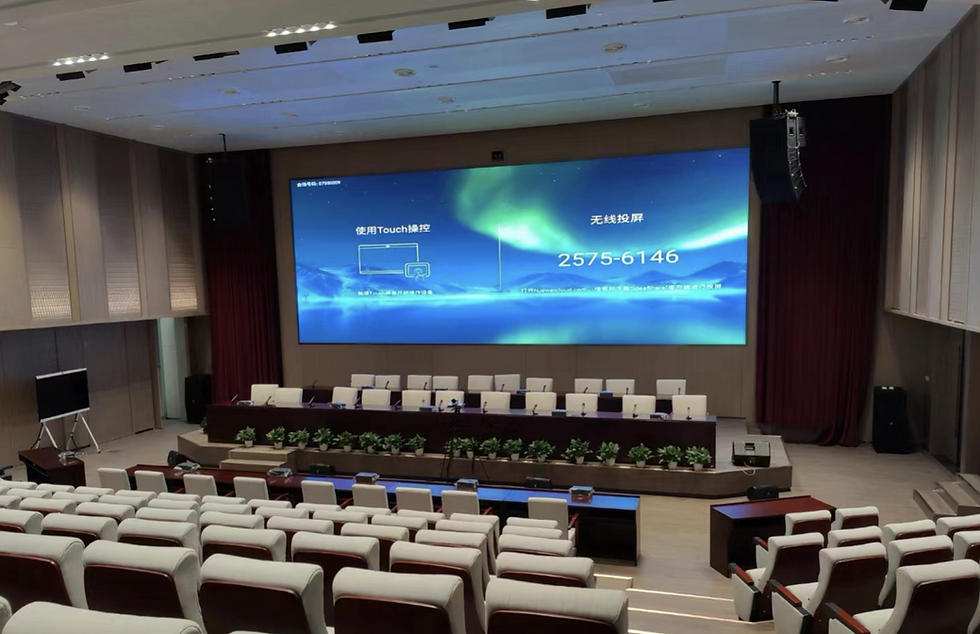Why Indoor LED Displays Have Replaced Projectors in Conference Rooms and Auditoriums
- LEKLED
- 7 days ago
- 3 min read
From the perspective of industry development, the debate between early LED displays and projectors in indoor usage has gradually been resolved with technological advancements. Below is a professional analysis of this issue, tied to the recent trends in industry development and technological improvements:
1. Early LED Displays vs. Projectors: A Historical Debate
Early LED Displays: High brightness, mainly designed for outdoor use. When used indoors, they often appeared too bright and lacked brightness adjustment features.
Projectors: Lower brightness, suitable for dark environments, but suffered from lower resolution, significant influence from ambient light, and high maintenance costs due to frequent bulb replacements.
This debate was valid in earlier times. However, with continuous technological advancements, LED displays have gradually surpassed projectors in performance and adaptability, particularly in conference rooms and auditoriums.

2. Technological Advancements in LED Displays
In recent years, the rapid development of LED display technology has enabled them to replace traditional projectors on a large scale in indoor applications, addressing key issues such as:
Brightness Adjustment
Optimized Brightness for Indoor Use: Modern indoor LED displays typically have a brightness of around 500 nits, specifically designed for conference rooms, auditoriums, and similar indoor settings. This brightness range ensures clear visibility without being overly harsh on the eyes.
Manual and Automatic Adjustment Features: Current LED control systems allow manual brightness adjustments, and some models even support ambient light sensing for automatic brightness adjustments, ensuring the screen remains suitable for the environment.
Improved Visual Comfort
Low Blue Light Technology: New-generation LED displays reduce eye strain by using low blue light technology.
Anti-Glare Treatment: Special coatings or surface treatments effectively minimize light reflection from the screen, further enhancing visual comfort.
High Resolution and Display Quality
Modern LED displays easily achieve 1080p, 4K, or even 8K resolutions, delivering sharp, detailed images that meet the highest presentation and display requirements.
Significant improvements in color performance allow for more vivid and accurate reproduction, particularly when showcasing graphics, images, and multimedia content.
Longevity and Maintenance
LED displays have a lifespan exceeding 50,000 hours, far outlasting projector bulbs.
Maintenance costs are minimal, as there is no need for frequent component replacements, making them more economical in the long run.
3. Why LED Displays Have Become the Mainstream Choice
Over the past 5 years, conference rooms and auditoriums have widely replaced old equipment with LED displays due to the following core advantages:
Adaptability in Brightness:
LED displays can adjust brightness to suit different indoor lighting conditions, solving the problem of glare associated with early LED screens.
Superior Image Quality:
The resolution and color performance of LED displays far exceed those of projectors, providing clear, vibrant visuals suitable for high-demand presentations.
Ease of Installation and Maintenance:
LED displays are highly flexible in installation and can be customized to fit specific venues. At the same time, they eliminate the frequent bulb replacement required by projectors.
Energy Efficiency:
Modern LED displays are more energy-efficient, with significantly reduced power consumption, aligning with sustainable and eco-friendly trends.
4. Addressing Concerns About Brightness Affecting Presenters
In response to concerns about brightness potentially affecting presenters, it can be confidently stated that this issue is no longer a problem today:
Controllable Brightness: Modern LED displays allow brightness to be adjusted according to the ambient light and the presenter's needs, ensuring clear visibility without being glaring.
Eye-Friendly Design: Technologies like low blue light and anti-glare make LED displays more comfortable for both presenters and audiences.
Scenario-Specific Design: Indoor LED displays are explicitly designed for conference rooms and auditoriums, differing significantly from the high-brightness outdoor models of the past, and are better suited to presentation scenarios.
5. Conclusion
With advancements in technology, LED displays have surpassed traditional projectors in terms of brightness, resolution, lifespan, and maintenance costs. The rapid development of the industry and the widespread replacement of equipment with LED displays demonstrate their maturity and suitability for indoor applications.
Thus, we can confidently assert that concerns about brightness are no longer an obstacle. Modern LED displays in indoor settings fully meet the needs of presenters and audiences, making them the preferred choice for conference rooms and auditoriums.

Comments